by Rhonda M. Tranks
All photos are copyrighted property of
Rhonda M. Tranks.
Just how far back do we need to go before we declare food to be "authentic" to a cuisine?
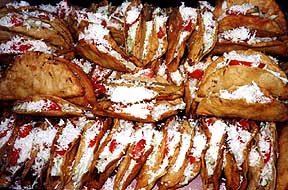
Gorditas (little fat ones) for sale - stuffed with beans,
chicken, tomatoes, rajas and sprinkled with aged cheese.
Tamales are authentically Mexican aren't they? They go back to pre-Hispanic times: masa, meat and vegetable fillings and corn husk or banana leaf wrappings - all local ingredients. But what we eat as tamales today are quite different from the pre-Hispanic version. Most contain lard or cooking oil as shortening; baking powder as a leaven and often pork and cheese in the filling. Sweet tamales contain cane sugar and often milk. All these ingredients were introduced after the Conquest and the arrival of the Spanish, but they are now integral ingredients of "traditional" Mexican food. The wonderful array of pastries and cakes we eat in Mexico are a direct consequence of the historically disastrous (but gastronomically fortunate) French intervention. What is "Mexican" food anyway? We talk of Poblano food, Yucatecan food, Norte�o food - so there are regional styles and ingredients, and a cuisine also develops with time.
Most dishes had their origins in something else. Invasions, royal marriages, emigration, immigration, trade, travel, curiosity and the human fascination with novelty all play their part in moving ingredients and dishes around the world.
It's hard to imagine Indian and Thai food without the fire of lies, Ireland without
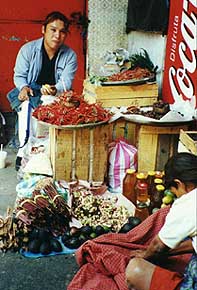
Finding ingredients in the markets |
Imagine Ireland without the comfort of potatoes, Turkey
without eggplant, Columbia without coffee or even Mexico
without tequila. But all these ingredients or techniques are
imports to the region with which they are now so closely
identified. As new ingredients are incorporated what happens
to authenticity? What happened when the first trader from the
gulf brought cacao or chocolate to the residents of Mexico's
central plateau? Maybe some cranky, traditionalist cook from
the kitchens of Netzahualcoyotl rejected it as being
unauthentic ... until it was tasted, and we've all been
happier ever since! (10 points to anyone who can tell me when
chocolate moved from the coast to the central plateau.) |
With the growth of interest in "ethnic" cuisines, many food writers and restaurant critics have reproached those who depart from the authenticity of food and recipes. Yet the same food writers and people who dismiss ethnic dishes which are not slavish to the original, wax lyrical about the latest food fads and joke about food which is no longer fashionable. They want foreign cuisines to be frozen in time (and thus remain quaint), yet our own cuisines are allowed to evolve and respond to external influences.
The historical and cultural aspects of food fascinate me: tracking down the origins of ingredients, researching how dishes evolve and making connections between culture and cuisine. Like language, food is inextricably linked to our identity and memory. And like language, a cuisine evolves. Human beings are naturally creative and curious. We were also given taste buds to enjoy flavors. We're driven to experiment, adapt and adopt. Francis Bacon said "Acorns were good until bread was found". We travel and migrate, taking our taste memories with us and then incorporate the new. Cuisines and cultures which do not absorb and evolve slowly atrophy or fossilize.
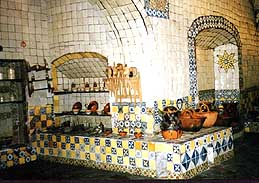
Kitchens of the ex-convento de Santa Rosa
in Puebla. Scene of the supposed invention of
the famous Mole Poblano
Culinary anthropologists help us record
dishes before they are lost to endless mutations, but a cuisine
should be allowed to evolve. The irony is that the much-touted
authentic version is often a major disappointment to our taste
buds. There may be an excellent reason why someone altered the
dish. A new ingredient came along which tasted or behaved
better. Many medieval recipes make fascinating reading, but the
execution leaves a lot to be desired in the taste department.
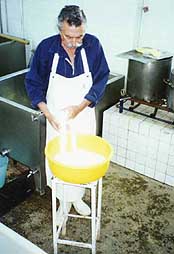
Se�or Cuevas of Rancho Cuevas
near Cuernavaca making Oaxaca
style cheese by hand. |
I don't know the origins of Nachos. They are considered Mexican food, but are possibly more Tex-Mex. They've travelled well and I've eaten Nachos in Mexico (often terrible), the US, England and even Italy, but by far the best were in the Seaford pub - a working class beer barn near where we used to live in Australia. I doubt if the cook and patrons had ever been to Texas, let alone Mexico. It was far from authentic - but it always tasted wonderful! Someone in the kitchen was busy adapting and being creative, in search of something which tasted better.
|
I thank the master chef above who has allowed me to taste so many wonderful things which are a direct consequence of food fusion over the centuries. Next time you enjoy guacamole, tostadas and beer, or coffee and pan dulce or tequila and quesadillas - consider what fortuitous combinations some cook or tippler dreamed up and rejoice in fusion food. More importantly most of the people I know are a cocktail of genes as well.
The following simple recipe comes from Vanessa Musi the chef for our 4 day course in traditional and contemporary Mexican cuisine, here in Cuernavaca, Mexico.
A Mexican food fan would quickly recognize the style of dish, ingredients and tastes as distinctly from here. What makes us recognize that it is from Mexico? The only indigenous ingredients are the tomatoes and the chile, and even that is in a sauce which developed sometime in the 18th or 19th century. The origin of noodles? We'll leave that to the Marco Polo debate, but wheat is not native to this region. Pre-hispanic Indians did not have pork (for the chorizo and the chicharron / pork crackling). Nor did they have chickens for the stock, or milk for cheese or cream. Olive oil, pepper, even cilantro are not indigenous to the area. So what makes it authentic? Maybe it is authentically colonial? Maybe authentically 1950?s. But what about the bottle of Maggi seasoning....
Fideos Secos con Chorizo al Chipotle y Chicharron
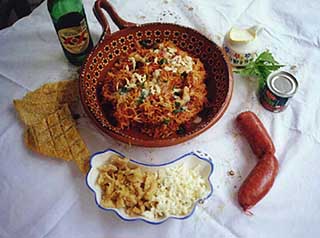
(Noodles with chorizo sausage, chile chipotle & pork crackling)
This is also called a "dry soup". Contact the author for the origins of this unusual culinary term.
- 250 g (8oz) fideos cortes (short, very thin wheat noodles)
- 2 roma tomatoes
- 1/4 large white onion
- 1 medium garlic clove
- 1 - 3 tablespoons (depending on your personal heat register) chile chipotle in adobe sauce (we use Del Monte brand)
- 150 g (6oz) best quality chorizo sausage, without skin, finely chopped
- 1 tabsp olive oil
- 2 -3 cups chicken stock
- 100 g (4 oz) fresh but firm cheese, grated (here we use Panela)
- salt, pepper and Maggi seasoning to taste
- 50g (2 oz) fresh chicharron, chopped (optional, but use fresh pork crackling or rinds if you can it)
- cilantro or epazote leaves to decorate
- 1/2 - 3/4 cup fresh ranch cream (A slightly soured cream used a lot in Mexico - use creme fraiche or mix some sour cream with fresh pouring cream).
- slices of avocado (optional)
Puree the tomatoes, onion and garlic in a blender.
Heat oil in a lidded pan or casserole. Add chorizo and saute over medium / low heat until golden - be careful not to burn. Reserving the oil and fat in the pan, drain the chorizo on paper towels.
Add a little more oil to the pan if necessary, heat and add fideos. Cook over medium heat, stirring with a wooden spoon until golden brown (about 5 minutes). Drain excess oil.
Add puree, chile chipotle in sauce and cook until sauce changes colour. Add chicken broth, starting with 2 cups and add more only if needed. Cook, covered over low heat, about 5 minutes. Uncover and cook longer until liquid evaporates and fideos are cooked but not mushy. Check and adjust seasonings, adding more chipotle if you wish. Serve hot, with chorizo and all garnishes arranged on top.
Editor's Note: Along with her husband, Pearsall, Rhonda Tranks lives in the City of Eternal Spring, Cuernavaca. They run a culture tour company, called Las Campanas, catering to the traveller who wishes to glimpse the traditional, culture and "culinary" side of Mexico. Part of the "tour itinerary" are cultural cooking classes. You can e-mail Rhonda at lascampanas@infosel.net.mx.
Do you have a unique story about Mexico, it's history, culture or your own travels that our readers might enjoy here on Mexonline.com? If so we'd be happy to read it and consider it for inclusion into our Feature Stories section. Just take a look at our writer's guidelines for more information and how to send us your story. Let's hear from you!
|